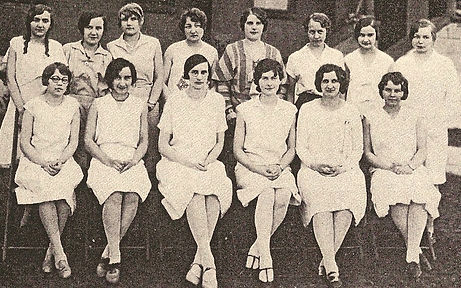Luther Seminary/St. Paul-Luther College
St. Paul, Minnesota
1884-1935
Travel
I made a lucky guess that any yearbooks or publications of Luther Seminary would have traveled with the school to Wartburg Seminary in 1935. The archive staff at Wartburg confirmed that such was indeed the case and kindly invited me to stop by and look at their holdings. After taking the winding road up to the bluffs above Dubuque, I thought that I was back in the Missouri Ozarks. This feeling was strengthened when the archivist began asking about closed Missouri colleges in which her father might have taught. Her assistant wanted to know if Paula’s Café in Mayville, ND still served the real rhubarb pie. My visit turned out to be very productive.


History
Luther Seminary, College, and Academy, a tertiary structure, was founded by the Joint Synod of Ohio (German Lutherans) at Afton, MN in 1884. In 1893, it was moved to St Paul, MN.
Earliest copies of the Luther Echo show an all-male student body. The 1918 yearbook shows a student body of 26 seminarians, 36 collegians and 25 academy students. There were two literary societies—the Hans Sachs Verein for the study of German language and literature and the Chi Alpha Pi. Students published a newspaper in addition to the Luther Echo. Musical groups included a glee club, a concert band, an orchestra and a chorus. There was also an Ernst Missionary Society, named for the president.
(Above) Women's Glee Club (1931 Luther Echo, Courtesy of Wartburg Seminary Archives)
But the 1928 graduating class from the college shows one female among the nine graduates. By 1931 there was a significant female presence on campus as shown by the yearbook photo of the Glee Club. Additionally, co-eds formed a Women Self-Government Association and Girl’s Missionary Society and of course became an essential part of dramatic and musical performances.
In 1931 St. Paul-Luther became a two-year college. In 1932 Luther seminary was merged with Wartburg Seminary at Waverly, IA; in 1935 the college was merged with Wartburg College.
Bricks and Mortar
Recitation Hall was built on 15 acres in what is now Phalen Park in St. Paul. In 1911 two new buildings were added—a classroom building and a dormitory. The physical address for the campus was “s. s. Hyacinth bet Cyprus and Earl.” Today that area appears to be a residential area close to Lake Phalen and the Phalen Park Golf Course.
Sports
Colors: Black and Gold
Luther Seminary fielded teams in football, basketball, baseball and hockey. Female students formed a Women’s Athletic Association, but did not play intercollegiate sports.
Earliest issues of Luther Echo show football teams participating against teams in the region. Luther’s most common opponents were St. John’s, Augsburg, Martin Luther, and Rochester JC in Minnesota and Eau Claire Normal and Stout Institute from Wisconsin. The best season was 1931 when the team won four of six games, defeating Martin Luther, Fort Snelling, Park Region, and Hamline with losses to St. John’s and Stout.
After Luther became a two-year school, the football schedule began to include more two-year schools such as Park Region (MN), and Waldorf (IA).

(Above) The 1917 Football Team (1918 Luther Echo, Courtesy of Wartburg Seminary Archives)
Note: Images are used in accordance with their “terms of use” as I understand those terms. Recopying or republishing these images may be restricted or forbidden.